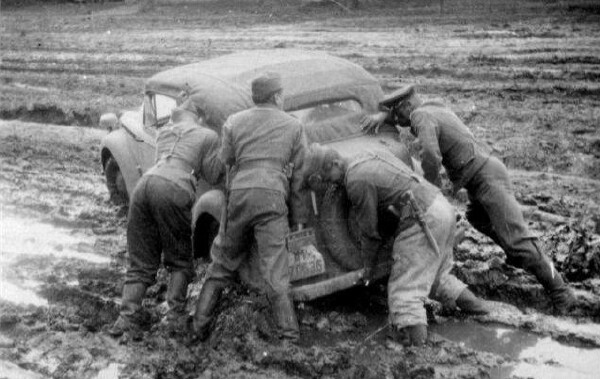
Mud!
Every game about the invasion of Russia includes the rasputitsa, the name for the spring and autumn muddy season when rain or the spring thaw renders the roads impassable. Something I didn’t know until I looked it up for this article is that there is a corresponding Finnish word, rospuutto, which translates to “roadlessness”. Is that true, Finnish readers? Who said wargames don’t teach you anything?
I remember reading a comment somewhere that said if Russia had possessed a central European road system in 1941 it almost certainly would have fallen to the Germans. I wish I had the quote here in front of me, because it’s intriguing. If you read the history and see the photographs of October 1941 on the approaches to Moscow, it sure seems like a reasonable conclusion. The absence of hard-surfaced roads paralyzed the German war machine as roads became impassable. Col. Albert Seaton’s Battle for Moscow, which I mentioned last time, has some good descriptions.
Most roads and tracks had disappeared and those remaining were so few in number that several divisions were allocated to a single route, this congestion slowing down the rate of march. No wheeled motor vehicles accompanied the columns. Although the progress of the dismounted men was painfully slow, that of the horses in harness was even slower. In the end the infantry companies were ordered on ahead and they left behind them the vehicle-loaded stores, heavy radio and ammunition and the horse-drawn anti-tank guns and artillery. Fleeter of foot, they began to overtake other units and formations, no further effort being made to keep a march table, so that regiments and divisions became mixed and broken up.
Which brings us to another design dilemma in Operation Barbarossa games: weather. Without rules for mud and snow, you really can’t claim to model the problems faced by the historical combatants. Seaton goes on to conclude that the weather pretty much decided the outcome of the battle for Moscow.
There is, in fact, little doubt that the German advance, which at first promised to be as rapid and spectacular as any of those of the late summer, abruptly petered out because of the weather and the state of the ground. In the first fortnight of the Typhoon offensive Army Group Center destroyed at least 700,000 of the Soviet defenders at little cost to itself and with another three weeks of dry and clear weather would have been in Moscow. No Russian could have stopped it.
That’s the conclusion you might draw playing any number of wargames. Avalon Hill’s classic The Russian Campaign (recently reprinted in a 4th edition by L2 Design Group) was notorious for its random weather, in which clear weather in November/December (if you rolled a “1″) would basically give the Germans the game (whereas a roll of “6″ in September/October for Mud would absolutely stop them cold). But if you played the “historical weather” variant (which was popular for game balance reasons) you knew exactly what was coming, and when. How does this “simulate actual historical problems” the way hex wargames so confidently purport to do?
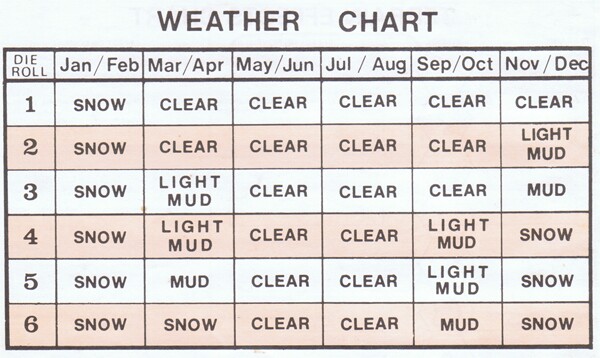
Not well, that’s for sure. But even though the winter of 1941-2 is cited as being the worst in a hundred years, the chances of clear weather persisting through the rasputitsa season into December were what? One in a thousand? Never mind one in twelve (the chances of two more turns of clear weather in The Russian Campaign). We don’t even get that here in North Carolina.
Col. Seaton is a bit inconsistent as to what exactly was to blame for the German defeat, because after that previous comment about clear weather, he later qualifies it.
It would be entirely wrong to attribute the German failure solely to weather or misfortune; the main failure was that of misjudgment and mistiming. The offensive had been mounted too late in the year, at a season when the weather was due to break up. A secondary cause was the lack of understanding of the effects on mobile operations of the weather and the ground, and the third was the ever-present problem of inadequacy of resources. Too much had been asked of German troops, and strengths had been allowed to drop too low.
But in a game about a historical event defined by misjudgment, mistiming, and misunderstanding of pretty much everything to do with supply and the weather, it doesn’t do to spell it all out to the player beforehand, does it? Not only did I know the mud was coming in my game (on Turn 18), but I knew exactly what it would do to my supply situation. At least theoretically. For example, let’s look at the manual, page 266.
20.4.1. Tracing supply
In order to receive supply, a combat unit first attempts to trace a path to the headquarters unit to which it is attached. The combat unit must be within both five hexes and twenty MPs of the applicable headquarters unit. In order for a headquarters unit to provide supply to its attached combat and support units, it in turn must be within both 25 hexes and 100 MPs of a railhead.
Supply is traced at the motorized unit movement cost, which is affected by weather as follows:

So mud has by far the worst weather effect on supply, because a clear hex that cost one movement point previously now costs five. Suddenly, being within 100 movement points of a railhead means at most 20 hexes. No wonder my southern forces are all isolated.
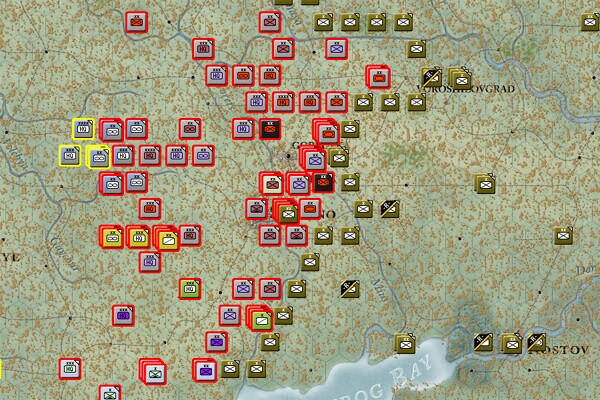
All the units outlined in red are out of supply. By contrast, in the north, I’ve pushed my railheads very close to the front line, with a northern spur into Kaluga and a southern spur passing through Bryansk, approaching Orel. This is probably why the units of Army Group Center are in a reasonable state of supply.
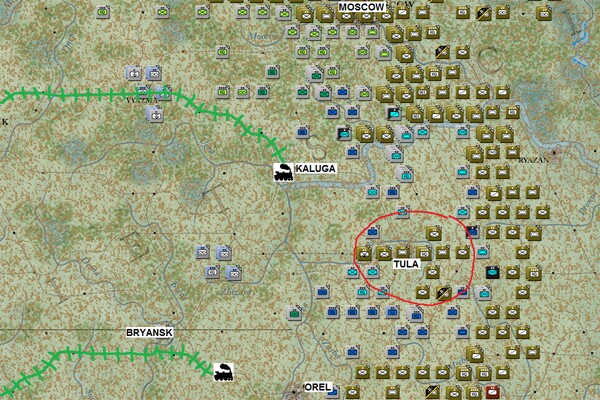
Furthermore, I just noticed this incredibly important fact under Headquarters Units and Supply on page 262.
Vehicles in the motor pool are used to move supply from the railhead to the HQ unit. If there are extra vehicles available in the motor pool, then the HQ units will start to stockpile excess supplies and fuel in dumps so as to minimize future needs from the railhead. Each dump contains one ton of supplies or fuel. Headquarters units serving as the supply source for their attached units will first use their dumps and then attempt to draw the remaining needed supply from the nearest rail head. When an HQ unit moves, it instantaneously takes vehicles out of the motor pool in order to move its dumps. The amount taken depends on the percent of the HQ units MPs that are used. If it uses 100 percent of its MPs for the turn, it will take one vehicle for each dump in the HQ unit.
So each time I move my headquarters units, I’m reducing the amount of supply I can distribute to their subordinate units. Unfortunately, there is no way I can effectively follow this supply dance, as my current motor pool is 176,000 vehicles. There is, however, a way to show supply distances using the rail damage info hotkey. The manual even has a nice picture.

The mud also had severe effects on my combat effectiveness, because stacks of units with initial combat strengths of over 100 for some reason end up with modified strengths of under 10, while Soviet strengths are modified similarly in the opposite direction. I’m not completely sure about the details.
Still, I’ve managed to encircle a substantial Soviet force around Tula, and a smaller group at the town of Serpukhov on the Oka River. I’ve also captured Stalino in the south, which yields another 2 victory points per turn. But my biggest achievement comes on Turn 21, in the Army Group North sector.
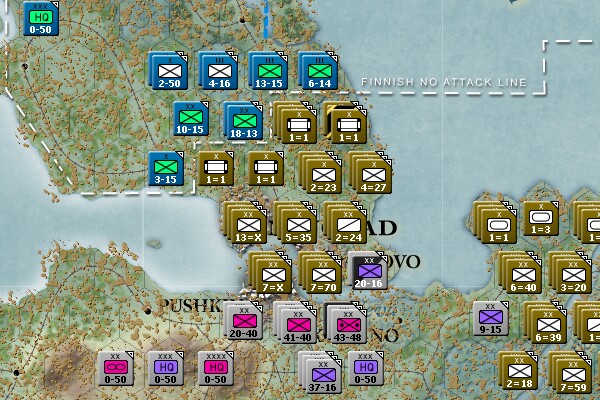
As you can see, I’ve crossed the Neva River and now have a bridgehead to the east of Leningrad, adjacent to the suburb of Pavlovo. If I can expand this quickly, I have a chance of taking the city, which I believe is now isolated and relying on sea and air supply.
Three turns left!
Discussion
No comments yet.